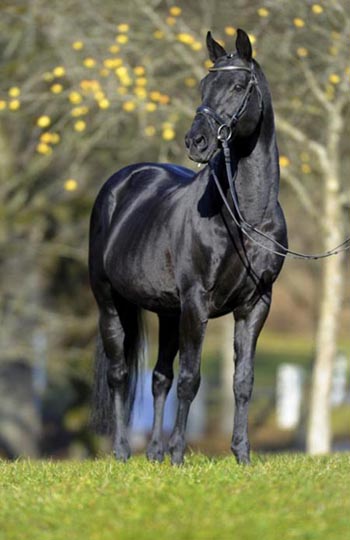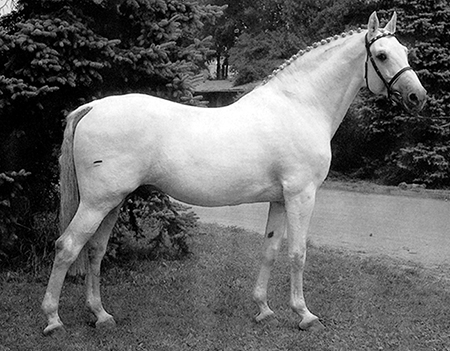Christopher Hector looks at the bloodlines on show at Caen
D is for Dressage – D is for Donnerhall
When we look at the start list for the dressage at the WEG, the first thing we need to observe – yet again – is the outright dominance of the Donnerhall line. He, himself, is represented by four competitors, a total only matched by his son, De Niro. Donnerhall is further represented by two sons, Donnerschlag and Don Cardinale. Another son, Don Gregory is represented by two of his sons, Don Davidhoff and Don Ruto. De Niro’s son, Danone I is also the sire of one competitor. That’s thirteen D-liners out of 103, almost 13%, and it will be interesting to see if this percentage grows when we look at the top 15 performers.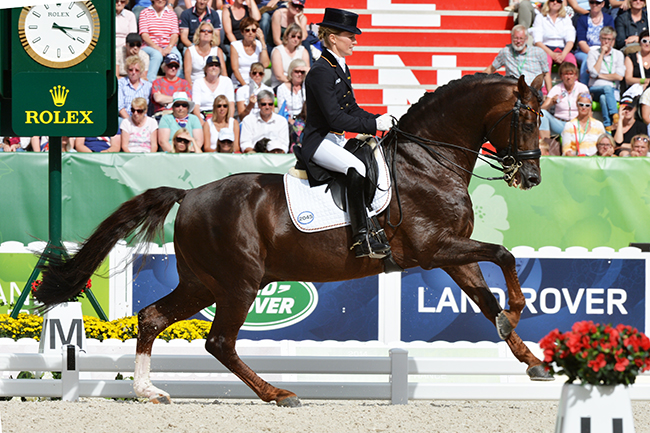
Donnerhall at its finest – Damon Hill
The Trakehner, Gribaldi, and the half-Trakehner, Michellino, each provide three competitors, then there are six stallions each represented by two, Sandro Hit (both ridden by Australians), Rohdiamant, Solos Carex, Florestan, Come Back II and Jazz.
In the Freestyle, the percentage of D’s has risen to 46.66 (7 out of 15). Three by the grand old man himself, the rest by four of his sons. In terms of studbooks, the Dutch lead with seven representatives, with the next largest book the Hanoverians with three, but it gets a little more balanced when we add one Oldenburg and one Westfalien to make it five German to seven Dutch horses… although this is still a statistic that will cause some heartburn in Deutschland, especially when the gold medallist, Valegro, is solidly Dutch bred three generations back…
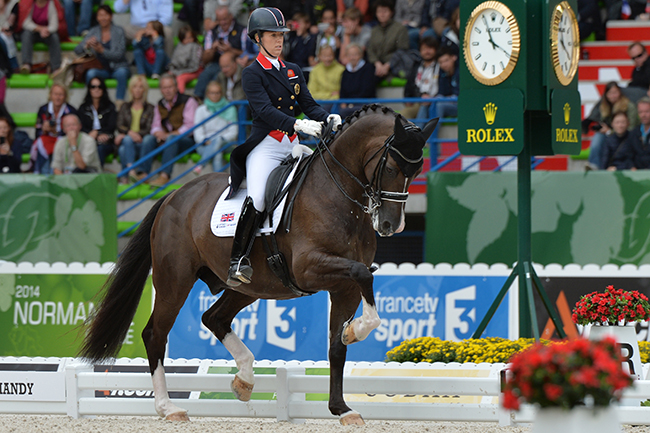
Valegro – the best son of Negro to date
Valegro’s sire Negro was a small tour dressage horse before he was injured, and he has been a moderately successful sire, although none of his progeny are remotely as successful as Valegro, but the stand out rising star of the WEG, Verdades proves that you don’t need a gilt edge pedigree to become a star. The bay gelding is by the unheralded Westfalien stallion, Florett As, by the great Florestan, out of a mare by the less than great, Urofino, but it is on Verdades’ dam line that things start to get wild…
His dam, Liwilarda, is by Goya, a grandson of the very famous carriage stallion, Renovo, who is by the Hackney, Cambridge Cole, with a couple of crosses of the old agricultural Dutch Gelderlanders. Her dam, Wilarda, is also by Renovo out of a Gelder mare. Not surprisingly Verdades has a ‘blood’ percentage of 9.77%. This is hardly the much-hyped modern Dutch dressage horse – I wouldn’t try telling that to Laura Graves though…
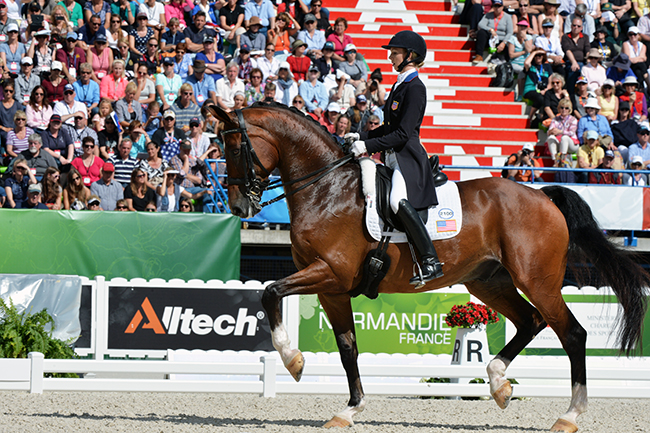
Verdades
Whatever they say, Thoroughbred still rules…
For all the talk of the new eventing sport and with it, the dominance of the European Warmblood, the results at Caen once again confirm that you need ‘blood’, Thoroughbred blood, to succeed at four-star level. Even on the entries you can see that most of the horses are at least 50% Thoroughbred even if that blood was hidden behind a range of European brands.
When you get to the top ten, then the concentration of blood becomes more obvious. Opgun Louvo is branded Selle Français, but the French have always reveled in the contribution of the Thoroughbred to their breed – 83.98 blood. His sire Shogun II is by the great French Thoroughbred, Night and Day and out of the dam of the showjumping Olympic gold medalist at Atlanta, Jus de Pomme, Opaline des Pins – and there is more blood there since she is by the Anglo Arab, Garitchou.
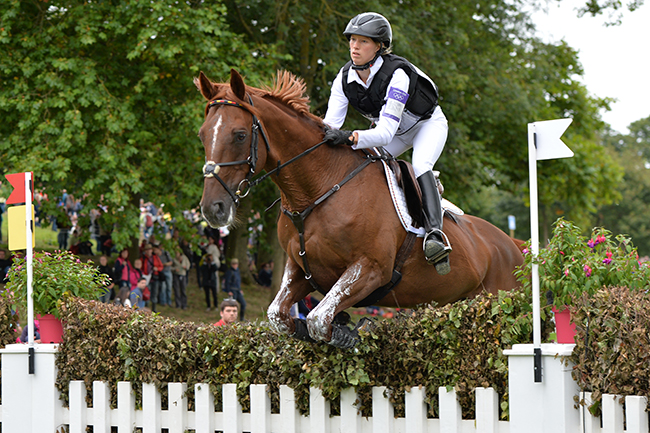
Opgun Louvo, the 2014 World Champion bred in Normandy
Opgun’s dam is by J’T’Adore, a grandson of the great Thoroughbred, Furioso, and her dam is by a son of the great Anglo sire, Nithard and out of a Thoroughbred mare.
Michael Jung’s silver medallist, FischerRocana FST is by Ituango xx, who stands at Marbach. Ituango moved from Brandenburg to Marbach in Germany’s south in 2012. He is seriously bred as a racehorse. His sire Acatenango was three times German racehorse of the year, won the German Derby and retired with winnings of €4,000,000. Ituango’s dam sire Lagunas is a Derby winner too, and produced four licensed stallions that are used for breeding with Warmbloods. Ituango himself raced for two years, for earnings of 138,000 Deutsch Mark with two Derby qualifications.
Rocana’s dam, Rose, is a right mix. She is by Carismo, a son of the Holsteiner, Calypso II, along with a few of those old but good Hanoverian names: Akzent II, Cavalier, Gotthard, and out of a mare by Scampolo (by Sandro out of a Gepard mare – two of the foundation sires of Paul Schockemöhle’s program) out of a mare of Saxon/Mecklenburg breeding. All that adds up to 63.87% blood.
The Throroughbred Ituango
Michael told me at Lion d’Angers last year, where he rode FischerRocana FST’s little sister, Ricona, that while he liked the Ituango foals he’d seen, he did not expect the stallion to equal that other great Thoroughbred who stood in the south, Heraldik.
“I think with Ituango you will need the quality from the mare. Heraldik was really good, with dressage movements and showjumping talent, and this Thoroughbred, Ituango, is just for racing, he doesn’t have the quality for the dressage or the showjumping.”
Do you prefer horses with a lot of Thoroughbred blood?
“You need it for the big four star competitions. Not for three star or two star, for that you need no Thoroughbred – but for the big competitions you need at least 50%.”
Rocana’s little sister, Ricona at Lion D’Angers last year
In third place we have Chilli Morning, bred up in the north of Germany in the Brandenburg breeding district. He is 62.89 blood, by the Thoroughbred, Phantomic, who won 11 times on the track for $139,000 in winnings – out of a mare by the great jumping sire, Kolibri, with more Thoroughbred on the mare line from Grollus xx.
The fourth line of the surprise packet of the WEG eventing, Classic Moet is unknown, but the other 75% is all Thoroughbred, by Classic xx out of a mare by Bohemond xx.
The fifth placegetter Qalao des Mers is 75.39% blood, by Iolisco de Quinhon by the Jalisco son, Olisco, out of a three quarters Anglo Arab mare.
Fletcha van‘t Verahof was bred by the world’s most successful showjumping breeder, Joris de Brabander, and is out of a full Thoroughbred mare by South Gale xx and is by one of the great stallions Joris bred, Vigo d’Arsouilles. The mare is 76.76% blood.
Holstein has had great success with the formula, Thoroughbred stallion over Holsteiner jumping mare, and Horseware’s Barny is no exception to the rule. He is by Barnaul, a Thoroughbred who raced and then jumped to 1.30 level, out of a Cornetto / Sylvester mare – so she descends from two Selle Français imports to Holstein, who had widely divergent careers, the one who had no competition career, Cor de la Bryère, was wildly successful at stud, the other, a highly successful international competitor with Michael Rüping, Silbersee, was a failure as a sire. Add to that a dash of Ramiro and you end up with 71.09% blood.
Shamwari is by the Thoroughbred Star Regent who was important in Friedrich Butt’s pioneering eventing breeding program (he was the dam sire of Butts Leon, a member of the gold medal team at Hong Kong), he is listed on the excellent Horse Telex website as being 59.18 ‘blood’ but with two Trakehner stallions on his dam line, the Warmblood percentage is perhaps less than it seems, since the Trakehners were always bred as riding, not agricultural horses, and happily absorbed Thoroughbred and Arab influences.
The ninth place getter, Nereo was bred by the former Spanish eventing rider, Ramon Beca, another with a deliberate breeding program aiming to produce eventers. His sire is the Thoroughbred, Fines. The dam sire is the Hanoverian Golfi, who combines the old-fashioned lines of Gotthard and Grande, but the grand dam is ‘unknown’. The 52.15% is more a guess than a statistical certainty.
Rounding out the top ten we have So is Et – Westfalien branded and by one of the more successful Thoroughbreds to stand at Celle, Sunlight (from the great Owen Tudor line) is out of a grand-daughter of Ramiro with some really ancient F line stallions filling out the pedigree. 59.77% blood but very nice blood.
So by all means add a dash of Warmblood movement and jump, but don’t forget that at the end of the day, blood will out.
Showjumping at the WEG
Let’s start with the good stuff, breeding. For showjumping fans half the fun is studying the bloodlines, and with the help of my Holstein based colleague, Adriana van Tilburg, the first day’s jumping hasn’t finished and we’ve got it nailed.
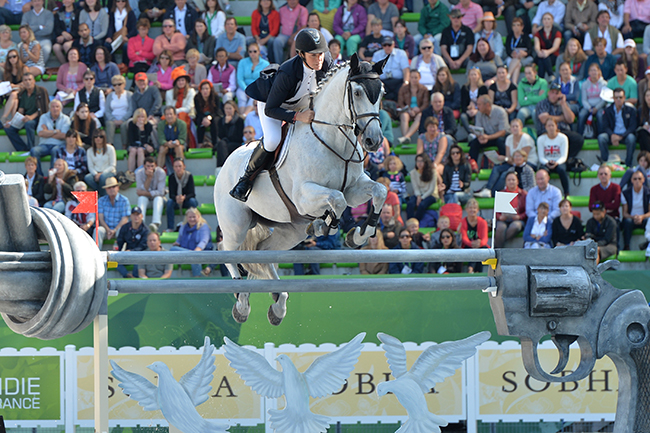
Amy Graham’s Bella Baloubet by Baloubet de Rouet and Kapitola by Landadel
The stallion line with the most representatives at the WEG is that dominating French line of Ibrahim with an astonishing 36, through Almé and Double Espoir. Most descend through Almé with the most influential representative his grandson, Baloubet de Rouet with five. Diamant de Sémilly from the Grand Veneur line, is represented by four.
The stallion with the most progeny at the WEG is the Cor de la Bryère great grandson, Cornet Obolensky who is represented by a total of seven representatives. In all that great French influence on Holstein breeding, the Cor de la Bryère line provides 24 of the contestants.
Okay that is not rocket science, Corde and Almé are the backbone of modern jumping breeding, but what did come as a bit of a shock is the influence of the less fashionable Capitol. The most represented Capitol line stallion is his son Cardento with six, but then there is Indoctro with four (three of them ridden by less than professional riders), Cassini I provides three, then there are two by Cento, one each for Canadian River and Centauer, two by Capitol’s grandson, Cumano, one by another grand-son, Colman and one by Capitol himself.
Capitol
Incidentally one of the Cumanos, Neptune de Brecourt is the product of the one season in France in 2000 when Cumano produced 61 foals out of fairly ‘normal’ mares, eleven of whom gained jumping indices of 150 or more, SIX of whom have won CSI classes. Arguably the greatest foal crop of a single season by any stallion anywhere.
We tend to think of Capitols as being big and scopey, slightly old fashioned and perhaps not the horses we need for modern sport, I guess we’ll have to watch carefully as the week goes on to see how many of them get to the final stages out of the 24 that present in the first round.
The foundation Holsteiner, Farn through his sons Nimmerdor and Wolfgang supplies 14 starters.
Once again we see the influence of another Selle Français export, Furioso II, with 12, mainly through his son, For Pleasure, who has three despite the fact that as a front line competitor he bred less foals than most of the top breeding stallions. Another Furioso son, Voltaire has four, his son, Kannan three, and another son, Gold de Becourt, one.
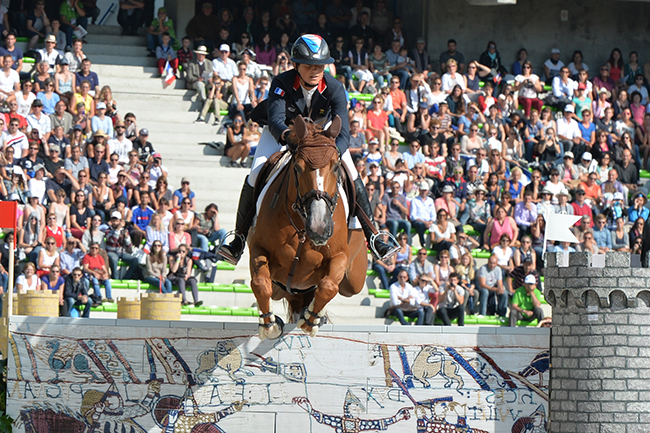
Penelope Leprevost’s Flora de Mariposa is by For Pleasure
The English Thoroughbred who played such a role in renovating the Holstein breed, Ladykiller is responsible for another 11.

